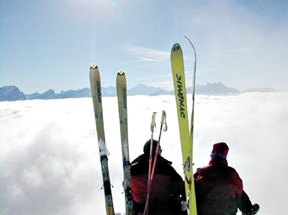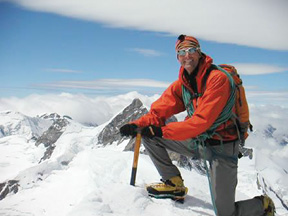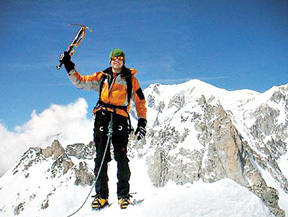Chesapeake Bay's Independent Newspaper ~ Since 1993
1629 Forest Drive, Annapolis, MD 21403 ~ 410-626-9888
Volume XVII, Issue 52 ~ December 24 - December 30, 2009
Home \\ Correspondence \\ from the Editor \\ Submit a Letter \\ Classifieds \\ Contact Us
Dining Guide \\ Home & Garden Guide \\ Archives \\ Distribution Locations \\ Advertising
![]()


Climbing to New Heights
Mountain climber Michael Silitch has left his hometown
of Annapolis for adventure in the Alps
by Katie Dodd
You are ascending Western Europe’s highest mountaintop, Mont-Blanc, about to experience one of the best ski spots in the world. A tram — the Aiguille du Midi — carries you up the mountainside, scaling an altitude of 12,600 feet above sea level. A spectacular view of the Alps welcomes you to the top.
You maneuver yourself, skis and poles in tow, from the security of the tram and scramble to latch your harness onto a safety line. You steer your way down a narrow ridge to a level place to begin your descent. On either side is a 50-degree declining slope. Your stomach churns with every downward glance, but you know you are safe under the wing of mountaineer guide Michael Silitch, who instructs you to follow in his tracks.
“I don’t like the feeling of standing on the edge of a cliff,” you say.
“You’re not supposed to like it,” Silitch responds. Standing on such precarious ground is assuredly against human nature, but you remind yourself that overriding your comfort zone is part of the reason you’re here.
Adrenaline junkies will take the steep drop straight down, but Silitch stays on the set course along the ridge. This is not to say he can’t handle the plunge; only that, on most occasions, he’s got up to eight people in his wake, relying on his expertise to lead them down the mountain safely. That is a responsibility Silitch does not take lightly.

Annapolis to Chamonix
Silitch’s love of adventure began at sea level. The son of craftswoman Natalie Silitch — whose Maryland Avenue antiques store he visited in November — sailed dinghies on Spa Creek as a boy. Natalie thinks the unheated room where baby Michael slept in a snowsuit helped his body adapt to the cold.
He also developed a passion for nature beyond the seaside. “When he was very little, there was a wonderful beech tree in the yard,” his mother says. “His father made him a climbing rope, and he spent all his time out there.”
Silitch seems to have grown up with an instinct for guiding. “As a family, we went camping almost every weekend,” Natalie continues. “We had a Volkswagen camper bus. We’d go to Virginia, West Virginia, Canada, Nova Scotia. Around eight or 10, Michael read the maps for me, put up the tents.”
New adventures drew Silitch to mountain peaks. In his three years of high school at Holderness School in New Hampshire’s White Mountains, he learned to rock climb and ski. College took him to St. John’s College, though not the campus of his hometown. This time he ventured cross-country to the campus in Santa Fe, New Mexico, where he took up cycling and joined the Search and Rescue team.
After graduation, Silitch worked for Outward Bound, led bike tours in the Alps and guided in Canada, Alaska and the Cascades for the American Alpine Institute. He tried trading in his skis and harness for textbooks and lab reports and was about to begin medical school when he set off for a last fling with guiding in Chamonix, France. He fell in love with the place. He and his wife Nina left the States to live their dream in one of the best mountaineering spots in the world.
Climbing the Mountain
Chamonix is a quaint, extreme-sports town of about 10,000 people, nestled at the base of Mont-Blanc. It is a place steeped in mountain-climbing tradition, originating in 1741 when two Englishmen discovered the Chamonix valley and glaciers. Since then it has been one of Europe’s top mountaineering destinations, whether for skiing, rock climbing or enjoying the magnificence of the Alps.
There the Silitches started their own guiding business, High Alpine Mountain Guides (www.high-alpine.com), conducting adventure trips from skiing to rock climbing to cycling.
“I had struggled to make a living as a mountain guide,” Silitch says. “The things you love are always the hardest to make a living at. When I moved to France, I wanted to start my own business.”

![]() As an American guide fluent in French, living year-round in Chamonix, Silitch has been able to build a wide client base by introducing Americans to high Alpine adventure. Silitch guides between 200 and 300 skiers each winter, and about 20 climbers in a summer. He leads only one or two people at a time on climbing trips.
As an American guide fluent in French, living year-round in Chamonix, Silitch has been able to build a wide client base by introducing Americans to high Alpine adventure. Silitch guides between 200 and 300 skiers each winter, and about 20 climbers in a summer. He leads only one or two people at a time on climbing trips.
“You find the epitome of Alpinism, of off-the-trail skiing in Chamonix,” says Annapolitan Dave Watt, who visited the town on a six-day ski trip led by Silitch last April. “Here, everyone’s within the boundaries of down-hill skiing; there, they’re all doing Alpinism. It’s not just ‘let’s go skiing’ — it’s ‘let’s go climbing, ice climbing, marathoning. They have Alpine boots that clip in, ice picks, packs, ropes, and they just take off.”
It’s not quite so simple as grab your equipment and go in these deadly elevations.
“My job as a mountain guide is to analyze risk, to pick objects based on weighing the risk versus my ability to manage that risk,” Silitch says. “Alpine guides teach clients and improve their skills.”
Even so, he knows that “in the mountains, there are things you can’t count on.”
Thus Silitch never goes up a mountain without the three items necessary for avalanche rescue: a shovel, a beacon and a probe.
“If you only bring one or two of those items, your search time is exponentially greater,” Silitch says. “But with all the equipment and training, the tools are very effective.”
Silitch is 49, but his tall, muscular frame maintained through his active lifestyle could belong to a man 20 years his junior. His smile is infectious, but there is also seriousness to him.
“He doesn’t mess around,” Watt says of Silitch’s guiding style. “He’s easy to get along with, but very disciplined about it.” This caution is likely one of the reasons he has been so successful with his business.
Summiting Young

Silitch’s skill has won him international acceptance as well as business. He is the only American guide who can boast membership in both the French and the Swiss Mountain Guide Associations, an honor earned after many years of experience in the Alps in addition to rigorous training courses.
Not only that, but Silitch has the potential to become a full-fledged member of the Compagniedes Guides de Chamonix, the largest and oldest mountain guide company in the world. He already is the first American to reach the second level — priority reinforcement — out of four required to be fully voted into this cadre. In the January vote, Silitch is hopeful he’ll be promoted to the third level, called stagaire.
“I think my chances are good,” he says. “I have a good rapport with everyone there.”
Whether or not the Compagniedes Guides de Chamonix decide to promote Silitch next month, he will continue to do what he loves most: climb mountains and share the experience with others.
“I find it really rewarding,” Silitch says, “at the end of a trip after a successful week or two with someone and all the experiences you’ve shared.”
Katie Dodd, a 24-year-old Boston College graduate from Annapolis, is job hunting and freelancing after a year's internship in London. Her last story for Bay Weekly, “Farewell, Market House,” appeared December 23 five years ago.
© COPYRIGHT 2009 by New Bay Enterprises, Inc. All rights reserved.
